Abstract
Background:
Different postdesigns and materials are available; however, no consensus exists regarding superiority for stress distribution. The aim of this study was to evaluate the effect of design and material of post with or without ferrule on stress distribution using finite element analysis.
Materials and Methods:
A total of 12 three-dimensional (3D) axisymmetric models of postretained central incisors were made: Six with ferrule design and six without it. Three of these six models had tapered posts, and three had parallel posts. The materials tested were titanium post with a composite resin core, nickel chromium cast post and core, and fiber reinforced composite (FRC) post with a composite resin core. The stress analysis was done using ANSYS software. The load of 100 N at an angle of 45 was applied 2 mm cervical to incisal edge on the palatal surface and results were analyzed using 3D von Mises criteria.
Results:
The highest amount of stress was in the cervical region. Overall, the stress in the tapered postsystem was more than the parallel one. FRC post and composite resin core recorded minimal stresses within the post but the stresses transmitted to cervical dentin were more as compared to other systems. Minimal stresses in cervical dentine were observed where the remaining coronal dentin was strengthen by ferrule.
Conclusion:
A rigid material with high modulus of elasticity for post and core system creates most uniform stress distribution pattern. Ferrule provides uniform distribution of stresses and decreases the cervical stresses.
Keywords: Dental prosthesis design, dental stress analyses, finite element analyses, post and core, technique
INTRODUCTION
Endodontic treatment can never be considered complete until the tooth has been restored to provide proper function consistent with the demand of the patient. Endodontically treated teeth, with a large amount of coronal tooth structure loss, frequently require the placement of a postinside the root canal, to retain a core for definitive restoration.[1,2] The primary function of the endodontic post is to retain the core, which subsequently provides a suitable foundation for final restoration placement. It also provides a substructure for anchoring a final restoration to the tooth.[3] The selection of postmaterial is based on its biocompatibility, mechanical properties, ease of fabrication, and availability in market and cost factor. Structurally compromised roots have conventionally been restored with casting posts and cores with the advantages of poststiffness, optimum adaptation, and high retention.[4] Metallic posts include titanium (Ti) and nickel-chromium (Ni-Cr) posts. Newer materials include ceramics and fiber reinforced resin[5,6,7] used for their unique esthetic properties and other positive features. The key element of tooth preparation, when using post and core is the incorporation of the ferrule. Extension of axial walls of the crown apical to missing tooth structure provides the ferrule. It helps to bind the remaining tooth structure and prevents root fracture during the function.[8,9] The effectiveness of ferrule has been evaluated by a variety of methods including stress analysis, electrical strain gauge, and photoelastic analysis. However, these methods have their own disadvantages.
Finite element analysis has become a popular tool in stress analysis and has been applied to dental biomechanics for two decades. Finite element method (FEM) is a numerical modeling tool, which provides a versatile method of analyzing stresses in any complex system. The advantages of this method are that it more closely simulates the natural conditions, reduces experimentation cost, avoids destructive experimentation, good reproducibility, and accuracy of the results and saves time.[10] Kumar and Rao[11] conducted a three-dimensional (3D) finite element analysis of stress distribution in teeth restored with metal and fiber posts of varying diameters and concluded that to reduce stress in the remaining radicular tooth structure, it is better to use a fiber post with a large diameter. Kainose et al.[12] evaluated the stress distribution in root filled teeth restored with a various post and core techniques using finite element linear analysis. Bessone et al.[13] analyzed the biomechanical behavior of anterior teeth using two different methods: FEM and experimental tests and concluded that restored teeth, in which the elastic modulus of the post was similar to that of the dentine and the material of the core had the best biomechanical performance.
The aim of this study was to predict, analyze, and compare stress distribution properties of Ni-Cr cast post and core, Ti post with composite resin core and fiber reinforced composite (FRC) post with composite resin core in endodontically treated maxillary central incisors restored with porcelain fused to metal crowns, with and without ferrule design.
MATERIALS AND METHODS
The dimensions of various parts in the finite element model for maxillary central incisor were adopted as given by various investigators.[14,15,16] Construction of the 3D models of different parts was carried out using 3D MAX software (Autodesk Foundation, CA, USA). An axisymmetric model was made representing the various parts of the structure, i.e., gutta percha, post, core, root, and crown. The files were created in the.iges format (a vendor-neutral file format that allows the digital exchange of information among computer-aided design systems) to transfer them to ANSYS version 10.0 (Swanson Analysis Inc., Houston, Tx, USA). A total of 12 models, 6 with ferrule design and another 6 without ferrule design were generated. Out of each of these 6 models, 3 had tapered post, and 3 had a parallel post. The ferrule design consisted of the bevel of 1.5 mm length at an angle of 35° created to give a metal collar all around. The materials tested were Ti post with a composite resin core; Ni-Cr cast post and core and fiber reinforced composite (FRC) post with a composite resin core.
The 3D models of different parts were imported and assembled in ANSYS to form the required model. Further, the element type was specified as the solid brick 8 node 45, an element with 8 nodes and the material properties of the various parts of the model according to the material to be tested were specified using the material properties option for the meshing purpose. The material properties specified were the modulus of elasticity and Poisson's ratio[7,17,18,19] [Table 1]. Using the material properties for each material and the element specified the model was meshed using the meshing tool. Meshing generated 279,805 elements interconnected by 53,340 nodes. Then the boundary conditions were applied on the nodes of the root surface to give them 0° of freedom in all the directions. The load of 100 N at an angle of 45° was applied 2 mm cervical to the incisal edge on the palatal surface.
Table 1.
Material properties in finite element model
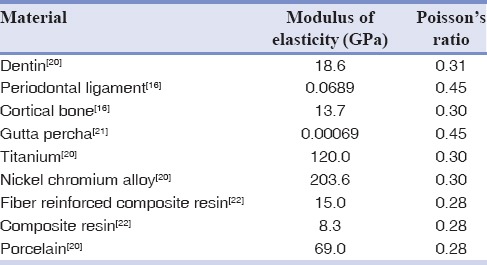
The data files created in the preprocessor were used by the solver to give solution for stresses, and displacement. The results obtained by solution were viewed graphically using “graphical user interface.” The results of the study were analyzed using the 3D von Mises criteria. The output for each material and type of post with or without ferrule was obtained as the color coded diagrams where similar colors depict the same range of stresses generated and warmer colors represent higher stresses. After the results were calculated, midsection of all the models in buccolingual direction were made to evaluate the stress patterns generated within the core, post, crown, and the root in the cervical region [Table 2]. The components of the models were also separated to obtain the individual components. The post being the components of interest was used to analyze the results [Table 3].
Table 2.
Stress distribution (MPa) in cervical dentin of models with different posts having ferrule and nonferrule design
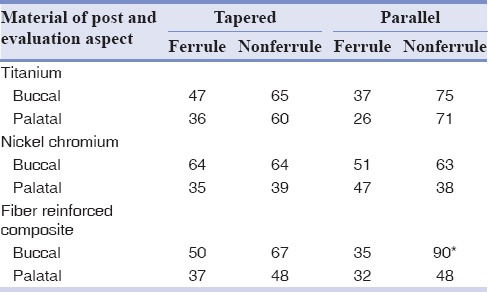
Table 3.
Stress distribution (MPa) in the studied models in different parts of the post
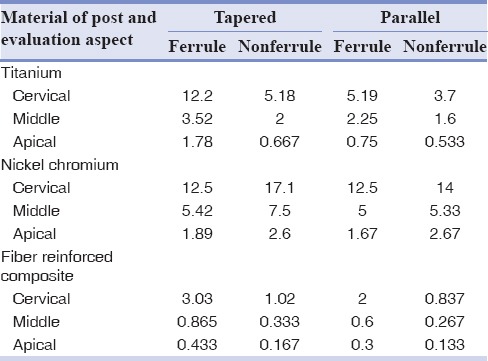
RESULTS
The highest magnitude of the stress in the post and core system was in the cervical region irrespective of the degree of taper, the material, and presence or absence of ferrule. Overall, the stress produced in the tapered posts was more as compared to the parallel postsirrespective of the material of the post and presence or absence of ferrule [Figures 1 and 2]. In all the FE models studied, a higher magnitude of stresses was observed on the buccal aspect of the cervical dentin as compared to the palatal aspect [Figure 3]. The maximum stress in cervical region was seen in FRC nonferrule post and core system (90 MPa) [Figure 3], however within the post, the maximum stress was seen in nonferrule Ni-Cr tapered post and core system (17.1 MPa) [Figure 1]. Although FRC postrecorded minimal amount of stress within the post (0.837 MPa) in all post and sore systems studied [Figure 4], the stresses transmitted to the surrounding dentin were highest (90 MPa). This value was much greater as compared to Ni-Cr cast post and core system [Figure 5]. The stresses produced in the cervical dentin are lesser when the ferrule is incorporated, irrespective of the material type, and degree of taper [Table 3]. The most uniform pattern of stress distribution was in ferrule Ni-Cr cast post and core system where stresses were in the range of 51 (palatal) and 47 (buccal) [Figure 5].
Figure 1.
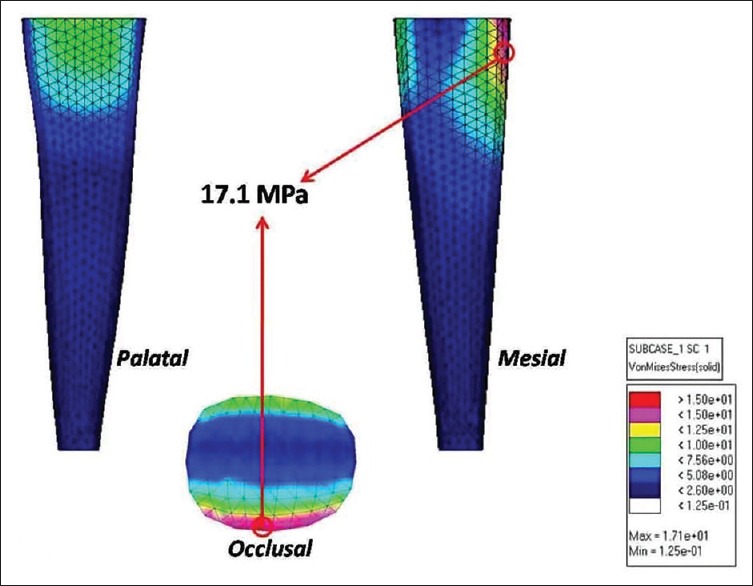
Stress distribution in nonferrule nickel chromium tapered post.
Figure 2.
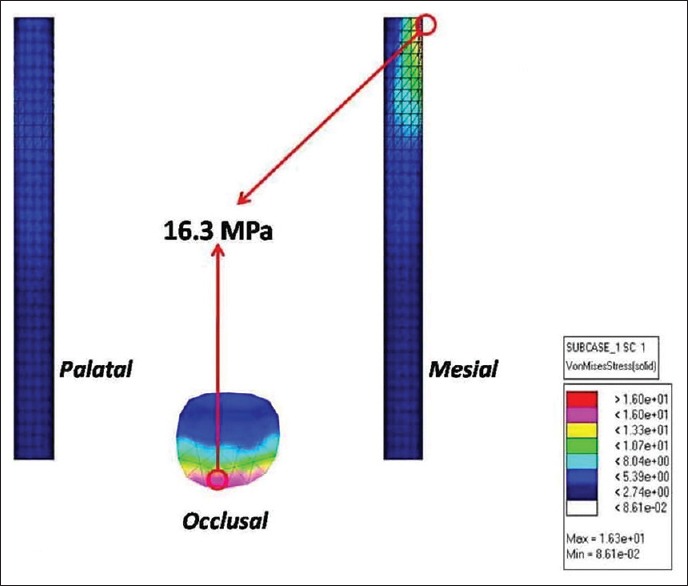
Stress distribution in nonferrule nickel chromium parallel post.
Figure 3.
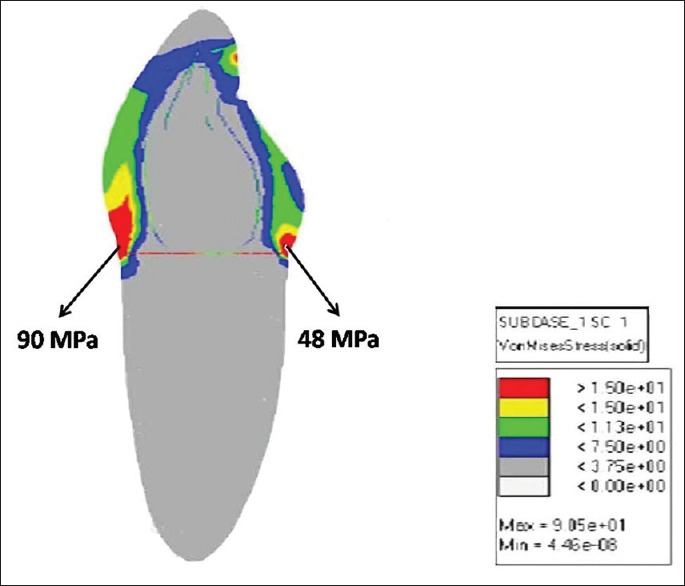
Stress distribution in cervical dentin for nonferrule fiber reinforced composite parallel post and composite resin core.
Figure 4.
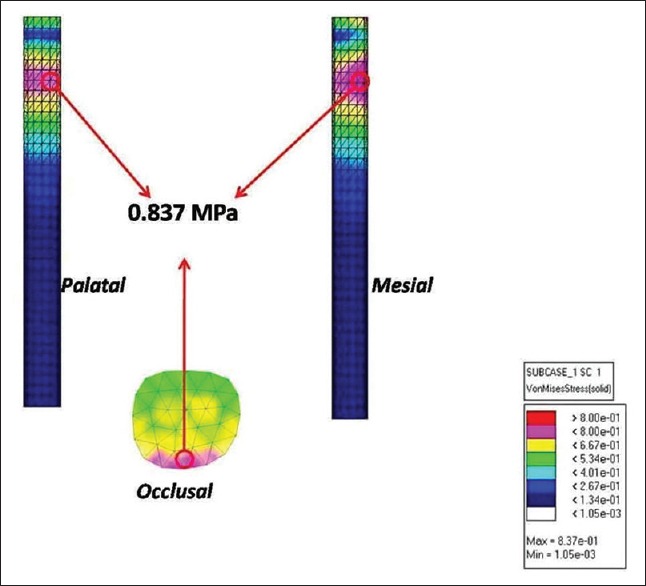
Stress distribution in nonferrule fiber reinforced composite parallel post.
Figure 5.
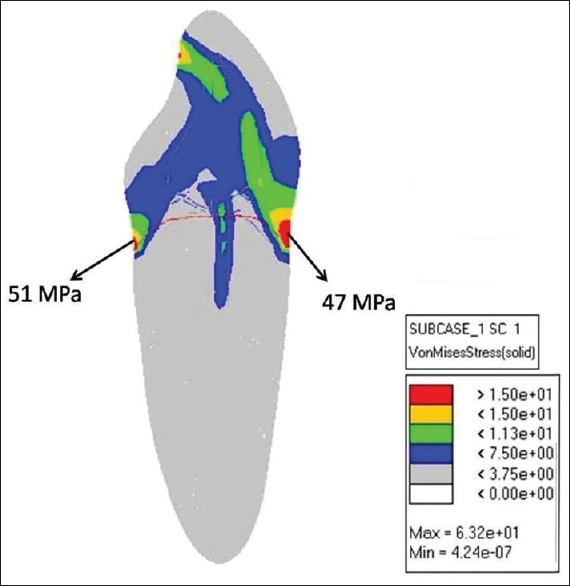
Stress distribution in cervical dentin for ferrule nickel chromium parallel post and nickel chromium core.
DISCUSSION
Intraorally, post and core restorations like any other restoration, are subjected to masticatory forces. The stress originated by the masticatory forces in an endodontically treated tooth restored with post and core can cause root fracture. Post and core restorations are multicomponent complex systems wherein the stress distribution within the structure is multi-axial, nonuniform, and depends on the magnitude and direction of the applied external loads. A theoretical well-known method for calculating stress distribution within such a complex structure is the FEM, which allows the investigators to evaluate the influence of model parameter variation, once the basic model has been correctly defined.
Overall stress transmitted by tapered posts was more and highest; irrespective of the other parameters such as the presence of ferrule or type of material; as compared to the parallel posts in both ferrule and nonferrule groups for all the three materials studied, i.e. Ti, Ni-Cr, and FRC.
The difference in stress values was observed in a cervical, middle, and apical third of the posts. Similar findings were found in the studies conducted by Peter et al.,[23] Cooney and Caputo.[24] They also concluded that tapered posts transmited greater stresses than parallel posts. The higher stresses in the case of tapered posts can be explained on the “wedging effect.” Overall stress observed within the FRC posts was least in magnitude as compared to the Ti posts and Ni-Cr posts irrespective of the presence of ferrule and type of material. On the evaluation of stress patterns in the cervical region, it was found that stresses transmited by the FRC posts (both tapered and parallel) without ferrule design were maximum (67 and 48 MPa on buccal and palatal aspect for tapered nonferrule group and 90 and 48 MPa for the parallel nonferrule group). This though being an advantage for the restoration, is a disadvantage for the supportive structure. This may be explained on the basis of smaller value of modulus of elasticity for FRC posts (15.0 GPa) as compared to the Ti (120 GPa) and Ni-Cr (203.6 GPa). The FRC material acting as a highly resilient material absorbs the stresses and dampens it, but the stresses are not distributed in a uniform manner on the whole complex. Similar findings were found in the study conducted by Eskitascioglu et al.[25] It was concluded by the study that FRC system transferred stress to the tooth; while stress accumulated within the postsystem was low. It was observed that ferrule plays an important role in the uniform distribution of the stresses by the post and core system when considered as a whole complex.
There is a clear indication that placement of ferrule does reduce the stresses in the cervical dentin for all the models studied irrespective of the material and design of the post. This observation is in accordance with studies by many researchers. Barkhordar et al.[8] examined the effect of the metal collar with approximately 30° tapered on the resistance of endodontically treated maxillary central incisors roots to fracture. They concluded that reinforcement by the metal collar was necessary to enhance resistance to root fracture. Libman and Nicholls[26] reported that preliminary failure occurred with a lower number of load cycles (4.0 kg) in endodontically treated central incisors with ferrule length of 0.5 and 1.0 mm as compared to 1.5 and 2.0 mm. Isidor et al.[9] reported that fracture resistance to cyclic loading increased significantly with increasing ferrule length. Al-Hazaimeh and Gutteridge[21] concluded that when composite cement and core materials were utilized with a prefabricated para postsystem, additional use of 2 mm ferrule preparation had no benefits in terms of resistance to root fracture. Lu et al.[20] found out that there was statistically significant difference in the fracture resistance between crowned teeth with and without 2 mm dentin ferrule. Pierrisnard et al.[22] in their FEM study reported that the absence of ferrule was a determining negative factor, giving rise to considerably higher stress levels. Akkayan[27] compared the effect of three different ferrule lengths on the fracture resistance of crowned endodontically treated teeth restored with four different esthetic dowel systems and found that teeth prepared with 2.01 mm ferrule demonstrated significantly higher fracture threshold. Aykent et al.[28] reported that presence of 1 mm of coronal dentin above the shoulder significantly increased the fracture strength of teeth restored with post and core system. Ichim et al.[29] in their FEM study reported that on increasing the ferrule height, displacement, and rotation of crown was reduced, maximum reduction occurring when the ferrule height reached 1.5 mm.
It was also observed in the study that the cervical stresses produced on the buccal aspect were greater as compared to the palatal aspect. This is because the load being applied on the palatal surface. Therefore, the resultant stress was developed on the buccal aspect. This observation was in accordance with the work conducted by Ichim et al.[29] They observed that when the crown was loaded on the palatal aspect at an angle of 120°, the crown displaced to the buccal side and rotated distally. They also found that on increasing the ferrule height, the displacement, and rotation of the crown reduced, maximum reduction was occured when ferrule height reached 1.5 mm.
The followings are the limitations of this study. The materials used in this study were considered homogenous and isotropic, also considered to be linearly elastic. In addition, the load applied to the FE model was static, whereas cyclic load of different magnitude is usually applied to the maxillary central incisors in the oral cavity. Thus, the results of this study should be considered with caution.
CONCLUSION
Within the limitations of this study it can be concluded that:
The incorporation of ferrule in remaining coronal dentine definitely reduced the stresses in cervical dentine
The maximum stresses were observed in the cervical region of the post and core system, irrespective of degree of tapering, material, and presence and absence of ferrule
Stress in the tapered posts was more than parallel posts
A rigid material with high modulus of elasticity exhibits the most uniform pattern of stress distribution within the whole complex and minimal stress transmission to the surrounding dentin.
Financial support and sponsorship
Nil.
Conflicts of interest
The authors of this manuscript declare that they have no conflicts of interest, real or perceived, financial or non-financial in this article.
REFERENCES
- 1.Toksavul S, Zor M, Toman M, Güngör MA, Nergiz I, Artunç C. Analysis of dentinal stress distribution of maxillary central incisors subjected to various post-and-core applications. Oper Dent. 2006;31:89–96. doi: 10.2341/04-192. [DOI] [PubMed] [Google Scholar]
- 2.Mosharraf R, Haerian A. Push-out bond strength of a fiber post system with two resin cements. Dent Res J (Isfahan) 2011;8(Suppl 1):S88–93. [PMC free article] [PubMed] [Google Scholar]
- 3.Cohen BI, Condos S, Musikant BL, Deutsch AS. Retention properties of a split-shaft threaded post: Cut at different apical lengths. J Prosthet Dent. 1992;68:894–8. doi: 10.1016/0022-3913(92)90546-m. [DOI] [PubMed] [Google Scholar]
- 4.Sharafeddin F, Alavi AA, Zare S. Fracture resistance of structurally compromised premolar roots restored with single and accessory glass or quartz fiber posts. Dent Res J (Isfahan) 2014;11:264–71. [PMC free article] [PubMed] [Google Scholar]
- 5.Martínez-Insua A, da Silva L, Rilo B, Santana U. Comparison of the fracture resistances of pulpless teeth restored with a cast post and core or carbon-fiber post with a composite core. J Prosthet Dent. 1998;80:527–32. doi: 10.1016/s0022-3913(98)70027-7. [DOI] [PubMed] [Google Scholar]
- 6.Meyenberg KH, Lüthy H, Schärer P. Zirconia posts: A new all-ceramic concept for nonvital abutment teeth. J Esthet Dent. 1995;7:73–80. doi: 10.1111/j.1708-8240.1995.tb00565.x. [DOI] [PubMed] [Google Scholar]
- 7.Viguie G, Malquarti G, Vincent B, Bourgeois D. Epoxy/carbon composite resins in dentistry: Mechanical properties related to fiber reinforcements. J Prosthet Dent. 1994;72:245–9. doi: 10.1016/0022-3913(94)90336-0. [DOI] [PubMed] [Google Scholar]
- 8.Barkhordar RA, Radke R, Abbasi J. Effect of metal collars on resistance of endodontically treated teeth to root fracture. J Prosthet Dent. 1989;61:676–8. doi: 10.1016/s0022-3913(89)80040-x. [DOI] [PubMed] [Google Scholar]
- 9.Isidor F, Brøndum K, Ravnholt G. The influence of post length and crown ferrule length on the resistance to cyclic loading of bovine teeth with prefabricated titanium posts. Int J Prosthodont. 1999;12:78–82. [PubMed] [Google Scholar]
- 10.Tirupathi RC, Ashok DB. Introduction to Finite Elements in Engineering. 2nd ed. New Delhi: Prentiz Hall of India Private Limited; 1997. pp. 1–20. [Google Scholar]
- 11.Kumar P, Rao RN. Three-dimensional finite element analysis of stress distribution in a tooth restored with metal and fiber posts of varying diameters: An in vitro study. J Conserv Dent. 2015;18:100–4. doi: 10.4103/0972-0707.153061. [DOI] [PMC free article] [PubMed] [Google Scholar]
- 12.Kainose K, Nakajima M, Foxton R, Wakabayashi N, Tagami J. Stress distribution in root filled teeth restored with various post and core techniques: Effect of post length and crown height. Int Endod J. 2015;48:1023–32. doi: 10.1111/iej.12397. [DOI] [PubMed] [Google Scholar]
- 13.Bessone L, Bodereau E, Cabanillas G, Dominguez A. Analysis of biomechanical behaviour of anterior teeth using two different methods: Finite element method and experimental tests. Engineering. 2014;6:148–58. [Google Scholar]
- 14.Rosentiel SF, Land MF, Fujimoto J. Contemporary Fixed Prosthodontics. 3rd ed. St. Louis: Mosby; 2001. pp. 272–312. [Google Scholar]
- 15.Lindhe J, Karring T. Textbook of Clinical Periodontology. 2nd ed. Philadelphia: Lea and Fabiger; 1991. p. 19. [Google Scholar]
- 16.Cohen S, Bums RC. Pathways of the Pulp. 6th ed. St. Louis: Mosby; 1994. pp. 604–32. [Google Scholar]
- 17.Weinstein AM, Klawitter JJ, Cook SD. Implant-bone interface characteristics of bioglass dental implants. J Biomed Mater Res. 1980;14:23–9. doi: 10.1002/jbm.820140104. [DOI] [PubMed] [Google Scholar]
- 18.Suansuwan N, Swain MV. Determination of elastic properties of metal alloys and dental porcelains. J Oral Rehabil. 2001;28:133–9. doi: 10.1046/j.1365-2842.2001.00642.x. [DOI] [PubMed] [Google Scholar]
- 19.Matsuo S, Watari F, Ohata N. Fabrication of a functionally graded dental composite resin post and core by laser lithography and finite element analysis of its stress relaxation effect on tooth root. Dent Mater J. 2001;20:257–74. doi: 10.4012/dmj.20.257. [DOI] [PubMed] [Google Scholar]
- 20.Lu Z, Zhang Y, Zhang W, Wang M. Influence of post-core on the strength of endodontically treated and crowned teeth. Zhonghua Kou Qiang Yi Xue Za Zhi. 2002;37:43–6. [PubMed] [Google Scholar]
- 21.Al-Hazaimeh N, Gutteridge DL. An in vitro study into the effect of the ferrule preparation on the fracture resistance of crowned teeth incorporating prefabricated post and composite core restorations. Int Endod J. 2001;34:40–6. doi: 10.1046/j.1365-2591.2001.00351.x. [DOI] [PubMed] [Google Scholar]
- 22.Pierrisnard L, Bohin F, Renault P, Barquins M. Corono-radicular reconstruction of pulpless teeth: A mechanical study using finite element analysis. J Prosthet Dent. 2002;88:442–8. doi: 10.1067/mpr.2002.128376. [DOI] [PubMed] [Google Scholar]
- 23.Peters MC, Poort HW, Farah JW, Craig RG. Stress analysis of a tooth restored with a post and core. J Dent Res. 1983;62:760–3. doi: 10.1177/00220345830620061501. [DOI] [PubMed] [Google Scholar]
- 24.Cooney JP, Caputo AA, Trabert KC. Retention and stress distribution of tapered-end endodontic posts. J Prosthet Dent. 1986;55:540–6. doi: 10.1016/0022-3913(86)90028-4. [DOI] [PubMed] [Google Scholar]
- 25.Eskitascioglu G, Belli S, Kalkan M. Evaluation of two post core systems using two different methods (fracture strength test and a finite elemental stress analysis) J Endod. 2002;28:629–33. doi: 10.1097/00004770-200209000-00001. [DOI] [PubMed] [Google Scholar]
- 26.Libman WJ, Nicholls JI. Load fatigue of teeth restored with cast posts and cores and complete crowns. Int J Prosthodont. 1995;8:155–61. [PubMed] [Google Scholar]
- 27.Akkayan B. An in vitro study evaluating the effect of ferrule length on fracture resistance of endodontically treated teeth restored with fiber-reinforced and zirconia dowel systems. J Prosthet Dent. 2004;92:155–62. doi: 10.1016/j.prosdent.2004.04.027. [DOI] [PubMed] [Google Scholar]
- 28.Aykent F, Kalkan M, Yucel MT, Ozyesil AG. Effect of dentin bonding and ferrule preparation on the fracture strength of crowned teeth restored with dowels and amalgam cores. J Prosthet Dent. 2006;95:297–301. doi: 10.1016/j.prosdent.2006.02.025. [DOI] [PubMed] [Google Scholar]
- 29.Ichim I, Kuzmanovic DV, Love RM. A finite element analysis of ferrule design on restoration resistance and distribution of stress within a root. Int Endod J. 2006;39:443–52. doi: 10.1111/j.1365-2591.2006.01085.x. [DOI] [PubMed] [Google Scholar]


